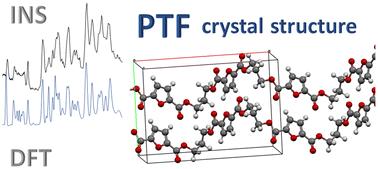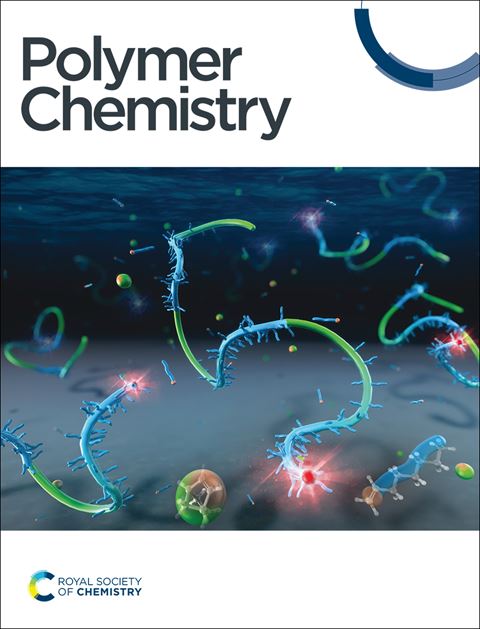聚(2,5-呋喃二甲酸三亚甲基酯)Redux 的晶体结构--计算光谱支持的新模型
IF 3.9
2区 化学
Q2 POLYMER SCIENCE
引用次数: 0
摘要
聚(2,5-呋喃二甲酸三亚甲基酯)(PTF)是一种新兴的生物基聚合物,其性能有可能超过化石基聚对苯二甲酸乙二醇酯。本研究结合计算化学和振动光谱学工具,阐明了 PTF 在结晶和无定形区域的构象偏好。这种方法不同于以往的研究,为这种重要的生物基聚合物的晶体结构提出了新的建议。在晶体结构域中,由于 1,3-丙二醇(PDO)链段中存在高-高-高扭结,PTF 链呈现螺旋构象,而 2,5-呋喃二甲酸酯(FDCA)分子则采用同步-同步模式。与聚(乙烯-2,5-呋喃二甲酸酯) (PEF) 和聚(丁烯-2,5-呋喃二甲酸酯) (PBF) 类似,同步 FDCA 单元允许在呋喃氢和相邻羰基之间形成大量的 C-H-O 接触。所提出的 PTF 晶体结构由 C-H-O 键连接的二维链片组成,这些链片相互堆叠,在呋喃环之间形成 π-π 相互作用。对 PTF 的红外和非弹性中子散射强度曲线进行了全面的振动分析,确定了对构象和结晶度敏感的振动模式,为今后采用振动光谱技术进行研究绘制了蓝图。本文章由计算机程序翻译,如有差异,请以英文原文为准。

Crystal structure of poly(trimethylene 2,5-furandicarboxylate) redux – a new model supported by computational spectroscopy†
Poly(trimethylene 2,5-furandicarboxylate) (PTF) is an emergent biobased polymer potentially able to outperform the fossil-based poly(ethylene terephthalate) counterpart. In this work, computational chemistry and vibrational spectroscopy tools are combined to elucidate the conformational preferences of PTF in both crystalline and amorphous regions. This approach departs from previous studies and leads to a new proposal for the crystal structure of this significant biobased polymer. In crystalline domains, PTF chains take on a helical conformation due to the gauche–gauche kinks present in 1,3-propanediol (PDO) segments, while 2,5-furandicarboxylate (FDCA) moieties adopt the syn–syn motif. Similarly to its counterparts, poly(ethylene 2,5-furandicarboxylate) (PEF) and poly(butylene 2,5-furandicarboxylate) (PBF), syn–syn FDCA units allow the formation of a vast array of C–H⋯O contacts between furanic hydrogens and adjacent carbonyl moieties. The proposed crystal structure of PTF consists of two-dimensional sheets of chains connected by C–H⋯O bonds, which are stacked upon one another forming π–π interactions among furanic rings. A thorough vibrational analysis of PTF's infrared and inelastic neutron scattering intensity profiles, with identification of vibrational modes sensitive to conformation and degree of crystallinity, sets a blueprint for future studies employing vibrational spectroscopy techniques.
求助全文
通过发布文献求助,成功后即可免费获取论文全文。
去求助
来源期刊

Polymer Chemistry
POLYMER SCIENCE-
CiteScore
8.60
自引率
8.70%
发文量
535
审稿时长
1.7 months
期刊介绍:
Polymer Chemistry welcomes submissions in all areas of polymer science that have a strong focus on macromolecular chemistry. Manuscripts may cover a broad range of fields, yet no direct application focus is required.
 求助内容:
求助内容: 应助结果提醒方式:
应助结果提醒方式:


